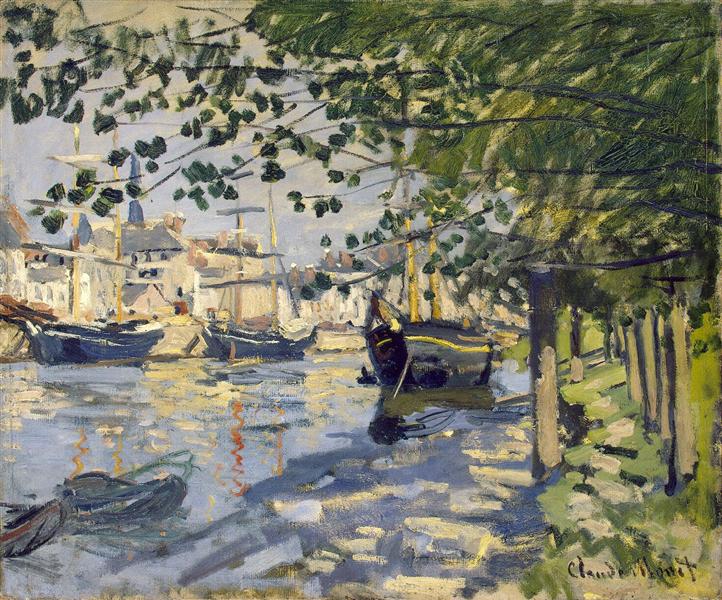Beskrivning
Claude Monet's painting "Seine at Rouen", painted in 1872, exemplifies one of the most significant stages of Impressionism, an artistic movement that sought to capture light and atmosphere through paint. This creation is a testament not only to Monet's mastery, but also to his vital relationship with nature and his urban environments, turning landscape painting into a vehicle for the exploration of visual perception.
When you look closely at the composition, the first thing that stands out is the way Monet arranges the elements on the canvas. With a seemingly simple structure, the River Seine occupies the central part and runs the length of the painting, favouring a perspective that invites the viewer to immerse themselves in the scene. The waters of the Seine become a mirror that reflects the world around it: the clouds, the sky and the boats that seem to float on its surface. This mirroring technique, characteristic of Monet's work, creates a sense of fluidity, of movement, captured in situ for an ephemeral moment.
The color palette used, mostly in shades of soft blue, gray, and shades of white and cream, evokes both the serenity of the landscape and the luminosity of the sky. Monet makes masterful use of light, varying its intensity and quality with the changes in the atmosphere, resulting in a dialogue between the countryside and the sky. The loose brushstrokes characteristic of his style convey a sense of immediacy and spontaneity, as if the artist had sought to capture that precise moment in time before it disappeared.
As for the figure of characters in the work, they are noticeably absent. Monet often chose to leave out the inclusion of human figures, allowing the landscape and natural elements to speak for themselves. In "Seine at Rouen", a few boats can be seen, which humanizes the surroundings and in turn suggests an everyday life, although these boats and their crew are not the main focus of the work. This bias towards the open landscape allows viewers to experience a pure connection with nature, an exhausting longing to break free from the shackles of modernity.
Another interesting aspect of “Seine at Rouen” is its relationship to the series of works Monet created of the same river and the same city. This serial approach is evocative of the desire to study the variations of light and weather in the same place. Monet portrayed the Seine at different times of day and seasons, an exercise that becomes an almost scientific engagement with visual perception and can be considered a precursor to the study of time in art. The choice of Rouen, an emblematic city in French history, not only in its natural beauty but also for its cultural relevance, lends an additional layer of meaning to the work.
Finally, The Seine at Rouen joins the rich tradition of landscape painting in art. Earlier painters such as Turner and Constable explored the landscape as a transcendent subject, but Monet takes this approach further, integrating his unique vision of Impressionism. The work, like the rest of his production, challenges the conventions of academic art of his time and anticipates a new way of seeing the world, in which personal experience and perception are the true guides. In this sense, The Seine at Rouen is not only a visual representation, but an invitation to reflect on the fleeting beauty of nature and its endless transformation.
KUADROS ©, a famous painting on your wall.
Hand-made oil painting reproductions, with the quality of professional artists and the distinctive seal of KUADROS ©.
Painting reproduction service with satisfaction guarantee. If you are not completely satisfied with the replica of your painting, we will refund 100% of your money.

